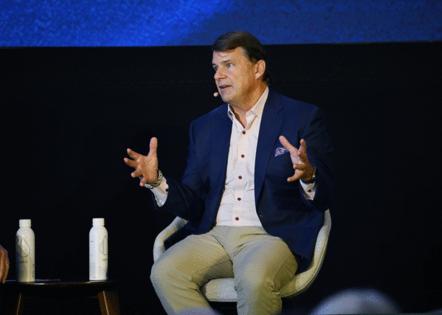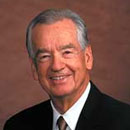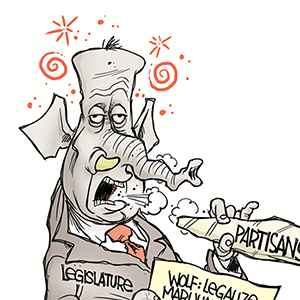Ford CEO predicts EV market share to fall by half after tax credit elimination
Published in Business News
DETROIT — Ford Motor Co. CEO Jim Farley on Tuesday said he wouldn't be surprised if electric vehicle sales in the United States fall by half after the expiration of the federal tax credit for plug-in vehicles.
Tuesday is the last day consumers could take advantage of the up-to-$7,500 tax credit, though Ford and General Motors Co. have found a workaround to continue offering taxpayer-funded discounts beyond the deadline. But that won't last forever, Farley said, and the impact of the end of the tax credit will be significant, especially with the U.S. Environmental Protection Agency ordered to roll back greenhouse gas emissions targets — opening opportunities for Ford in the mix of vehicles the automaker can sell.
"Customers are pesky," Farley said at the Ford Pro Accelerate conference at Michigan Central promoting skilled trades, manufacturing and other "essential economy" jobs and sectors. "They surprise you. They definitely surprised us. Customers are not interested in the $75,000 electric vehicle. ... I wouldn't be surprised if the EV sales in the U.S. go down to 5% of our industry from probably this month, 10%, 12%."
Still, Farley confirmed a Reuters report that the company will transition consumers away from government support. GM and Ford rolled out programs to their dealers that had the companies' financing arms purchase EVs in dealers’ inventory by making down payments on them, according to the report, which also was confirmed by spokespersons for the companies and documents provided to dealers. That means the discount can be offered on EV leases of existing stock into the fourth quarter.
"I don't want to imply at all that those kind of programs, they're going to last forever," said Farley, who is particularly looking at where prices go moving forward. "No, it's a transition."
In a statement, Ford said it's working to provide EV shoppers with competitive payments on retail leases through Ford Credit until Dec. 31.
Village Ford dealer Jim Seavitt in Dearborn, Michigan, said the program that runs through the end of the year will limit increases on leases of vehicles already in stock or in transit to $50 per month on the Mustang Mach-E and $60 to $70 per month on the F-150 Lightning.
"It’ll help me sell cars and prevents the payment from going through the roof," said Seavitt, who sold nine Mach-Es on Monday alone.
Longer term, EVs still will have a market for short-run commuter vehicles, but that's 5% to 7% of the market, Farley said. Dealer services company Cox Automotive Inc. forecasts sales of EVs during the third quarter will be up more than 21% from the same period a year ago. That would represent roughly 10% of U.S. sales, a record.
Although the halving of EVs sales is likely, Sam Abuelsamid, vice president of market research at auto communications agency Telemetry, said it's unlikely to endure. Upcoming launches like the Nissan Leaf, Chevrolet Bolt and Kia EV3 and EV4 will bring more affordable options to the market that haven't been present, spurring demand.
"They're going to be in that $30,000-ish, mid-$30,000 price range," Abuelsamid said. "As we get those more affordable EV models that still have good, strong range, I think a lot of EV intenders will be taking a hard look at those vehicles."
In contrast to EVs, Farley pointed to demand for hybrid F-150s that represent a third of the truck's U.S. sales, offering consumers advantages like the the ability to power their home or equipment on a job site with their vehicle's onboard generator.
"We have to make these partially electric vehicles in the factories that would have been EVs," Farley said. "What we do with all the battery plants — we'll fill them — but it will be more stress, because we had a four-year predictable policy. Now the policy changed."
Ford, however, hasn't abandoned EVs. The company in August announced a $2 billion investment in Kentucky's Louisville Assembly Plant to make a $30,000 midsize electric truck set to launch in 2027. Farley added that the U.S. market is in isolation, and Ford as a global company still must compete with EVs globally.
Farley's remarks came as he was emphasizing the role of manufacturing, construction and other blue-collar industries in the economy. Ford and its charitable arm plan to invest more than $5 million for workforce development in skilled trades, manufacturing and other "essential economy" sectors.
Three hundred industry and government leaders gathered at Michigan Central to discuss policies and actions to address workforce shortages, regulations and a lack of productivity and innovation compared to other sectors. The challenges, presenters said, hinder infrastructure development and the ability to lower costs of goods and services — and Ford's ability to sell its cash-cow pickup trucks and other commercial vehicles.
"We hear every day from our Pro customers that they are suffering from staffing issues, bureaucracy and lack of productivity," Farley said. "It's affecting Ford and our dealers; today, this morning, there'll be 6,000 empty stalls in our dealerships — no technicians to work at them."
As a part of the solutions offered, Ford and Ford Philanthropy said they will infuse funds for 2025-2026 to benefit more than 100,000 students and educators. That includes 15 Ford Future Builders Labs in Michigan and Tennessee to bring hands-on learning to K-12 students and a new partnership with SkillsUSA to expand advanced manufacturing and automotive programs to high school students.
A new Ford Philanthropy Advanced Manufacturing & Trade Scholarship also will cover training, tools and expenses for students pursuing careers in the skilled trades. In addition, the company will expand its Auto Tech Scholarship with TechForce Foundation, which has provided $7 million in financial support to 1,400 students since 2023.
Ford also is exploring with Bloomberg Philanthropies how to expand its model for encouraging skilled trades in high schools.
The Ford Essential Workforce Initiative also includes existing programs like the United Auto Workers-FordJoint Apprentice Program, nationwide auto tech recruiting and training partnerships, and FordPro services that emphasize productivity, including a new collaboration with software firm ServiceTitan.
"We have a lot of resources, but no single company, no organization (is) going to solve these issues alone," Farley said.
Based on a report released last year with the Aspen Institute, Ford emphasized that there is a shortage of 600,000 workers in manufacturing and 500,000 unfilled construction jobs. Approval times for power-connection requests have more than doubled since the early 2000s, it noted. Additionally, it raised concerns about cut federal spending on workforce services and research and development.
But Farley said the real solution is going to happen at more local levels: within states, counties and school districts in partnership with business. Farley said other countries have invested to a greater extent for these positions. He recalled a trip to Germany where an apprentice had been learning skills at Ford since middle school.
"Ultimately, this is about the success of our country," Farley said. "The problems in the essential economy are problems for all of us. They lead to inflation, higher housing costs, delays in projects, lack of opportunity."
The challenges in the essential economy resulted in an “epiphany” for Farley in 2023 during the United Auto Workers strike, he said. He heard about entry-level workers having to work three jobs to support their families.
“The old timers in our plants were saying, ‘It's no longer a career, Mr. Farley,' ” he said. “ ‘Working at Ford is no longer a career.’ ”
The record contract that resulted from the walkout moved temporary workers to full-time within 90 days, and created a three-year path to top pay. That’s a package that puts UAW members at the “top of the pyramid,” Farley said, but the conference sought to address problems for small businesses that don’t have those kinds of opportunities and resources.
Other business leaders also addressed how they are navigating the challenges as well as how their size eases their ability to accomplish projects. U.S. Steel Corp. CEO David Burritt discussed how Nippon Steel Corp.’s acquisition of the manufacturer is infusing it with almost $11 billion to be invested by 2028.
“We've got to work to make sure this essential economy is elevated and make sure that we have the people ready to do the work,” Burritt said. “And that happens when we get the permitting process done very quickly. And we now have governors coming to us, competing for this $4 billion mini-mill that we'll be developing, telling us they will fast-track the permits that we're going through right now.”
Michigan Gov. Gretchen Whitmer highlighted efforts in her administration to make college more affordable and increase career and technical education programs in high schools. In particular, she noted the Future for Frontliners program that came from the COVID-19 pandemic and sought to help essential workers return to school
“I've met techs that hospitals have taken advantage of it, grocery store stockers have taken advantage of it,” she said.
Roger Penske, chairman of logistics company Penske Corp., said internal hiring has been an important way for the company to minimize turnover.
“We fill the funnel from the bottom, and I would say that 95% of our management upgrade come from internally,” he said. “We bring in people that maybe worked in a drugstore, and two years later, they've got a technician job in our place, making $70,000 because of the training where we bring them in. It's been very, very productive for us.”
©2025 www.detroitnews.com. Visit at detroitnews.com. Distributed by Tribune Content Agency, LLC.












Comments